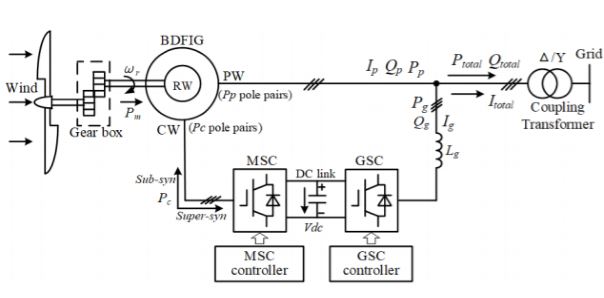Modeling and Coordinated Control Design for Brushless Doubly Fed Induction Generator-Based Wind Turbine to Withstand Grid Voltage Unbalance
Also Available Domains Power Quality
Objective
The main objective of the project is to eliminate unbalanced PW current, distorted CW current and oscillations of the PW active or reactive power were analyzed.
Abstract
In this project, Wind turbines must be able to withstand a certain level of grid voltage unbalance without tripping, according to grid codes. Existing controls for brushless doubly-fed induction generator (BDFIG)-based wind turbines under grid unbalance, on the other hand, have numerous issues, such as difficulty in realising decoupling control, involvement with flux or current estimations, and complex control structure. Furthermore, the existing Studies have primarily focused on the control of the machine side converter (MSC), but the coordinated control of MSC and grid side converter (GSC), as well as the overall control objectives of the BDFIG wind turbine system have not been addressed thus far. To address these issues and improve control capability, this paper proposes a coordinated control strategy that takes MSC and GSC into account. First, the improved control objectives for the overall BDFIG wind turbine system are established. Second, for MSC and GSC, simple single current closed-loop controllers are designed that do not involve any flux or current estimations. Meanwhile, all disturbances and cross-coupling terms on the dq axes are derived and used for feed forward control in current loops to achieve decoupling control and improve system dynamic response. The results show that the proposed control can effectively achieve the overall wind turbine system's control objectives while providing excellent dynamic and stable performance under grid voltage unbalance.
Keywords: Brushless doubly-fed induction generator (BDFIG), voltage unbalance, decoupling control, wind turbine, sequence decomposition.
NOTE: Without the concern of our team, please don't submit to the college. This Abstract varies based on student requirements.
Block Diagram

Specifications
Software Configuration:
Operating System : Windows 7/8/10
Application Software : Matlab/Simulink
Hardware Configuration:
RAM : 8 GB
Processor : I3 / I5(Mostly prefer)
Learning Outcomes
- Introduction to Matlab/Simulink
- What is EISPACK & LINPACK
- How to start with MATLAB
- About Matlab language
- About tools & libraries
- Application of Matlab/Simulink
- About Matlab desktop
- Features of Matlab/Simulink
- Basics on Matlab/Simulink
- Types of transformation
- Types of PWM
- Introduction to brushless doubly fed induction generator
- Introduction to grid side converters
- Introduction to machine side converters
- Introduction to Low Voltage Ride Through
- Introduction to wind turbines
- Introduction to PI Controllers
- Introduction to Clarks transformation
- Introduction to parks transformation
- Introduction to Inverse Clarks transformation
- Introduction to Inverse parks transformation
- Introduction to abc to dqo transformation
- Introduction to dqo to abc transformation
- Brief discussion about dc link voltage controller
- Brief discussion about parks transformation
- Brief discussion about Clarks transformation
- Brief discussion about inverse parks transformation
- Brief discussion about inverse Clarks transformation
- Project Development Skills:
- Problem analyzing skills
- Problem solving skills
- Creativity and imaginary skills
- Programming skills
- Deployment
- Testing skills
- Debugging skills
- Project presentation skills
- Thesis writing skills


 Paper Publishing
Paper Publishing
